Amirreza Fateh
BRISC: Annotated Dataset for Brain Tumor Segmentation and Classification with Swin-HAFNet
Jun 17, 2025Abstract:Accurate segmentation and classification of brain tumors from Magnetic Resonance Imaging (MRI) remain key challenges in medical image analysis, largely due to the lack of high-quality, balanced, and diverse datasets. In this work, we present a new curated MRI dataset designed specifically for brain tumor segmentation and classification tasks. The dataset comprises 6,000 contrast-enhanced T1-weighted MRI scans annotated by certified radiologists and physicians, spanning three major tumor types-glioma, meningioma, and pituitary-as well as non-tumorous cases. Each sample includes high-resolution labels and is categorized across axial, sagittal, and coronal imaging planes to facilitate robust model development and cross-view generalization. To demonstrate the utility of the dataset, we propose a transformer-based segmentation model and benchmark it against established baselines. Our method achieves the highest weighted mean Intersection-over-Union (IoU) of 82.3%, with improvements observed across all tumor categories. Importantly, this study serves primarily as an introduction to the dataset, establishing foundational benchmarks for future research. We envision this dataset as a valuable resource for advancing machine learning applications in neuro-oncology, supporting both academic research and clinical decision-support development. datasetlink: https://www.kaggle.com/datasets/briscdataset/brisc2025/
FusionLungNet: Multi-scale Fusion Convolution with Refinement Network for Lung CT Image Segmentation
Oct 21, 2024


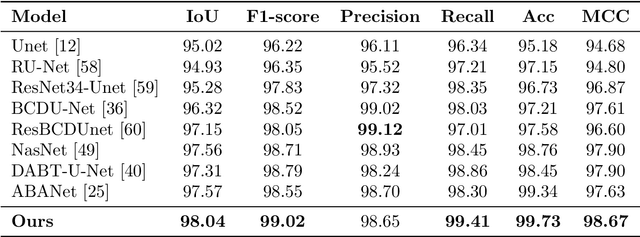
Abstract:Early detection of lung cancer is crucial as it increases the chances of successful treatment. Automatic lung image segmentation assists doctors in identifying diseases such as lung cancer, COVID-19, and respiratory disorders. However, lung segmentation is challenging due to overlapping features like vascular and bronchial structures, along with pixel-level fusion of brightness, color, and texture. New lung segmentation methods face difficulties in identifying long-range relationships between image components, reliance on convolution operations that may not capture all critical features, and the complex structures of the lungs. Furthermore, semantic gaps between feature maps can hinder the integration of relevant information, reducing model accuracy. Skip connections can also limit the decoder's access to complete information, resulting in partial information loss during encoding. To overcome these challenges, we propose a hybrid approach using the FusionLungNet network, which has a multi-level structure with key components, including the ResNet-50 encoder, Channel-wise Aggregation Attention (CAA) module, Multi-scale Feature Fusion (MFF) block, self refinement (SR) module, and multiple decoders. The refinement sub-network uses convolutional neural networks for image post-processing to improve quality. Our method employs a combination of loss functions, including SSIM, IOU, and focal loss, to optimize image reconstruction quality. We created and publicly released a new dataset for lung segmentation called LungSegDB, including 1800 CT images from the LIDC-IDRI dataset (dataset version 1) and 700 images from the Chest CT Cancer Images from Kaggle dataset (dataset version 2). Our method achieved an IOU score of 98.04, outperforming existing methods and demonstrating significant improvements in segmentation accuracy. https://github.com/sadjadrz/FusionLungNet
MSDNet: Multi-Scale Decoder for Few-Shot Semantic Segmentation via Transformer-Guided Prototyping
Sep 17, 2024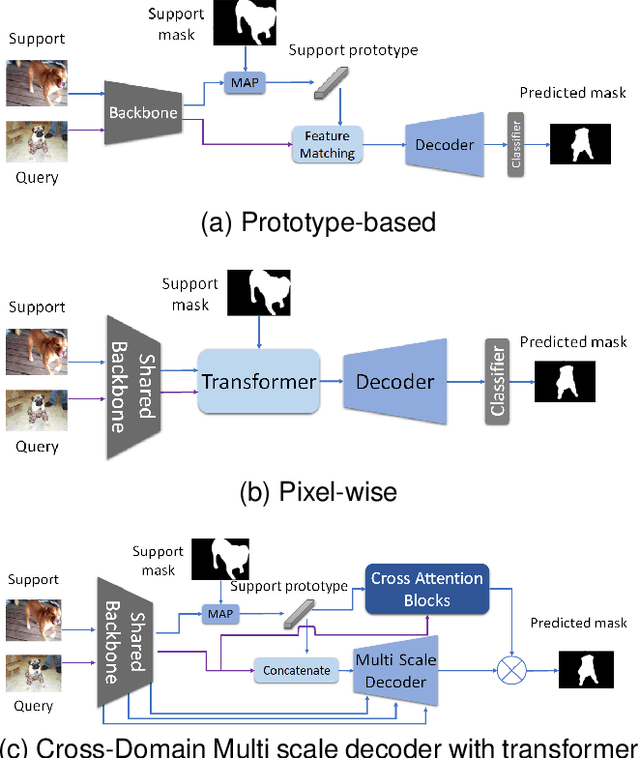
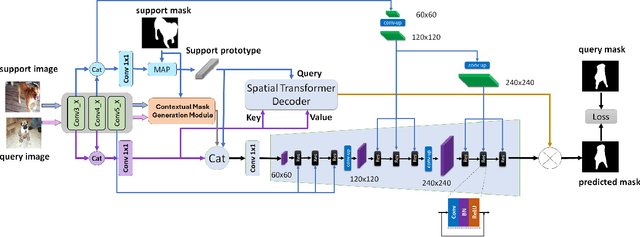
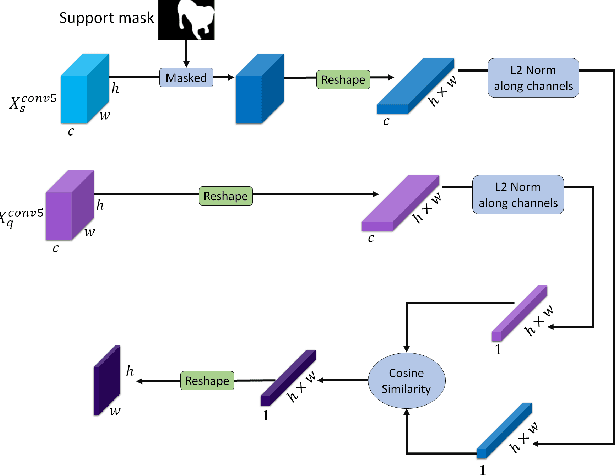

Abstract:Few-shot Semantic Segmentation addresses the challenge of segmenting objects in query images with only a handful of annotated examples. However, many previous state-of-the-art methods either have to discard intricate local semantic features or suffer from high computational complexity. To address these challenges, we propose a new Few-shot Semantic Segmentation framework based on the transformer architecture. Our approach introduces the spatial transformer decoder and the contextual mask generation module to improve the relational understanding between support and query images. Moreover, we introduce a multi-scale decoder to refine the segmentation mask by incorporating features from different resolutions in a hierarchical manner. Additionally, our approach integrates global features from intermediate encoder stages to improve contextual understanding, while maintaining a lightweight structure to reduce complexity. This balance between performance and efficiency enables our method to achieve state-of-the-art results on benchmark datasets such as $PASCAL-5^i$ and $COCO-20^i$ in both 1-shot and 5-shot settings. Notably, our model with only 1.5 million parameters demonstrates competitive performance while overcoming limitations of existing methodologies. https://github.com/amirrezafateh/MSDNet
Enhancing Few-Shot Image Classification through Learnable Multi-Scale Embedding and Attention Mechanisms
Sep 12, 2024Abstract:In the context of few-shot classification, the goal is to train a classifier using a limited number of samples while maintaining satisfactory performance. However, traditional metric-based methods exhibit certain limitations in achieving this objective. These methods typically rely on a single distance value between the query feature and support feature, thereby overlooking the contribution of shallow features. To overcome this challenge, we propose a novel approach in this paper. Our approach involves utilizing multi-output embedding network that maps samples into distinct feature spaces. The proposed method extract feature vectors at different stages, enabling the model to capture both global and abstract features. By utilizing these diverse feature spaces, our model enhances its performance. Moreover, employing a self-attention mechanism improves the refinement of features at each stage, leading to even more robust representations and improved overall performance. Furthermore, assigning learnable weights to each stage significantly improved performance and results. We conducted comprehensive evaluations on the MiniImageNet and FC100 datasets, specifically in the 5-way 1-shot and 5-way 5-shot scenarios. Additionally, we performed a cross-domain task from MiniImageNet to the CUB dataset, achieving high accuracy in the testing domain. These evaluations demonstrate the efficacy of our proposed method in comparison to state-of-the-art approaches. https://github.com/FatemehAskari/MSENet
Efficient and Accurate Pneumonia Detection Using a Novel Multi-Scale Transformer Approach
Aug 08, 2024

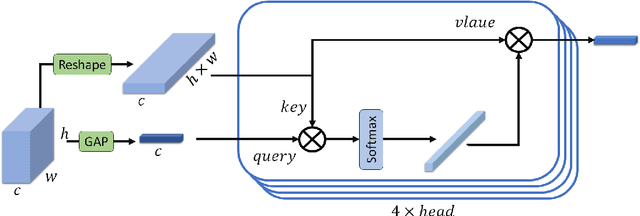

Abstract:Pneumonia, a severe respiratory disease, poses significant diagnostic challenges, especially in underdeveloped regions. Traditional diagnostic methods, such as chest X-rays, suffer from variability in interpretation among radiologists, necessitating reliable automated tools. In this study, we propose a novel approach combining deep learning and transformer-based attention mechanisms to enhance pneumonia detection from chest X-rays. Our method begins with lung segmentation using a TransUNet model that integrates our specialized transformer module, which has fewer parameters compared to common transformers while maintaining performance. This model is trained on the "Chest Xray Masks and Labels" dataset and then applied to the Kermany and Cohen datasets to isolate lung regions, enhancing subsequent classification tasks. For classification, we employ pre-trained ResNet models (ResNet-50 and ResNet-101) to extract multi-scale feature maps, processed through our modified transformer module. By employing our specialized transformer, we attain superior results with significantly fewer parameters compared to common transformer models. Our approach achieves high accuracy rates of 92.79% on the Kermany dataset and 95.11% on the Cohen dataset, ensuring robust and efficient performance suitable for resource-constrained environments. "https://github.com/amirrezafateh/Multi-Scale-Transformer-Pneumonia"
 Add to Chrome
Add to Chrome Add to Firefox
Add to Firefox Add to Edge
Add to Edge